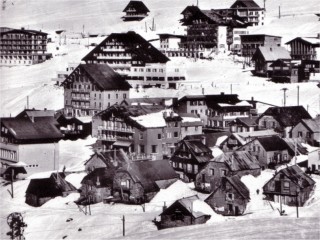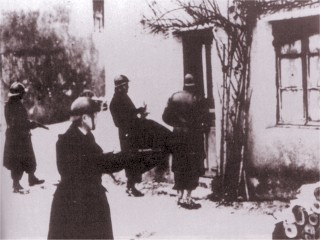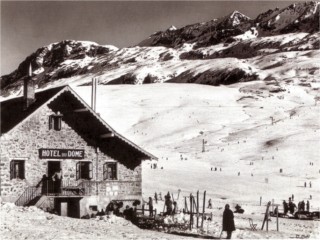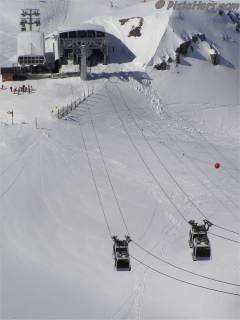
Ski-Areas > Northern Alps > Isère (38) > Oisans > l'Alpe d'Huez > History
LAlpe dHuez is one of the oldest French ski resorts. It sits in a large south-west facing bowl on an 1800 meter plateau above the town of Bourg dOisans. The sunny slopes have earned the resort the name of l'île au soleil (island of sunshine). The area has been inhabited since before the Romans conquered Gaul. The abrupt slopes, outcrops and gorges are places where the earths riches came close to the surface and were easy to extract. The Romans are said to have mined for silver, copper, zinc and coal amongst other minerals on the slopes. The ancient voie de Brande which crosses the plateau dates from Roman occupation. The names Combe Charbonniere and Chave (to dig in the franco-occitan dialect of the region) are reminders of this more industrial past.

l'Alpe d'Huez before the war
The locals believed in a mysterious lost city at the Brande between the modern altiport and the col de Sarenne. The silver mines were said to be guarded by ghostly fairies armed with scythes who would chop the heads off people exploring the ruins. They seemed to have left Hyppolyte Muller, an archaeologist who explored the remains, alone and it was his daughter, Marie, a school teacher in Huez, who introduced skiing to the slopes of the Grandes Rousses in 1911. As for the mines, records show they were producing silver from the 11th century where they had a fairly international mix of miners including a large contingent of Germans. They appear to have been abandoned in the 14th century with the onset of little ice-age. A victim of a different kind of climate change to the one facing ski resorts today.
Coal mining dates from at least the 18th century. The forests had been largely exhausted or were in retreat due to the cold climate. The remaining trees were jealously guarded by locals as they protected their villages from avalanches. In 1749 the villagers above Bourg dOisans had taken a court case banning local lumberjacks from felling trees above their houses. Coal was an ideal replacement for wood and the mines brought a number of developments to the area. In 1905 a cable car was installed to transport the coal. Six to eight thousand tonnes were being extracted each year. This also brought electricity to Huez, and the first accidents from electrocution. The road from Bourg dOisans slowly but steadily extended sky-wards. In 1881 it reached la Garde and Huez in the year the cable car was constructed. By 1923 it had reached lAlpe dHuez but measured just 4 meters at its widest point. This mean that the charabanc of Leandre Collomb which brought the first tourists to slopes in the 1920s had to make two attempts to corner the tightest hairpins. After the Great War the cable car was extended to Bourg dOisans using a to-and-fro system similar to the new Marmottes III cable car. It was powered by the weight of coal in the trucks.
Avalanches were a constant problem for the inhabitants. On the 7th February 1749 following exceptional snowfall a large accumulation of snow in the combe du Bras avalanched on Huez wiping out twenty houses, killing forty people despite a rapid search operation organised by the villagers. In the same year six miners were also killed by an avalanche extracting coal. The miners dormitory was hit on several occasions. On the 9th of February 1950 an avalanche destroyed the building, killing 12 miners as they slept. The mines closed shortly afterwards.
Towards the latter part of the 1920s the resort began to develop when the French Touring Club built a refuge in one of the alpine chalets. In 1928 the refuge opened for Christmas for the first time, with just five hardy guests, all from Paris. With a railhead at Bourg dOisans served by the VFD and a mule ride to the slopes skiers from nearby Grenoble and Lyon soon followed. In 1935 the refuge was bought by Maurice Rajon who along with Joseph Paganon, member of parliament for the Isère department and minister of works dreamed of building a cable car to the Pic Blanc. Maurices son Georges would later become a president of the lift company. In 1935 Paganon brought a turbine propelled Caterpillar snow plough to clear the road in winter and in 1936 found funds to improve the road. 7 meters wide, 21 spectacular hairpins, the mythic climb from Bourg dOisans to lAlpe dHuez was born. It was first used by the Tour de France in 1952 where it saw an epic duel between the legendary Coppi and Robic. The road was later improved for the 1968 Grenoble Olympics. LAlpe dHuez hosting the bob sledge competition.
All this development coincided with the introduction of paid holidays for workers by the Front Populaire government. It was a time for escaping the grim French industrial suburbs and exploring nature. Hotels started opening for the winter season. In 1933 the Bel Alpe and the Trois Dauphins, owned by the three Dauphin brothers. These were followed by the Edelweis on the 20th of December 1936 and the Génépi restaurant and shortly afterwards the Grand Hotel. By 1939 there were over a dozen hotels open during the winter months. Even the French President, Albert Lebrun, had holidayed at Paganons chalet. Paganon had advised the Huizats (residents of Huez) to avoid constructing any old building in any old spot. A thought echoed by the Tourist commissioner who advised the mayor of Huez that constructing random follies would diminish the value of the whole area. Advice that was, at least in part, ignored.

Hotel la Belle Alpe
During 1936 a ski school opened under the directorship of guide and author Rocher Frison-Roche. In the same year a Polish immigrant by the name of Jean Pomagalski bulit the first drag lift. Pomagalski was a champion oarsman in the coxless fours, favourite for the gold at the 1932 Los Angeles Olympics but his team decided not to travel as the French Federation had refused to pay expenses.
Pomas lift was on a long line on the slopes of the Eclose and was powered by electricity. It was the first modern tow and was the genesis of one of Frances industrial power-houses. By 1940 France had a total of 40 drag lifts and Poma had a worldwide patent on the design. Armand Moura a lumberjack and amateur inventor claimed that his lift design predated that of Pomagalski. In the same year as the Eclose he built a drag at the lac Blanc using old truck engine for power and using what parts he had to hand. At the time Pomas lift used poles fixed to the cable but this limited the maximum speed. Moura design poles that could disengage at the bottom station and reengage when the skier grabbed the pole giving a much faster cable speed (and sore nuts!). He patented the design in 1936 but let the patent lapse during the war years.
Mouras lifts had special tarrif for gens du pays the locals, Bourcats (from Bourg dOisans) and Huizats could use his lifts for free. He would tell them they could pay him in the afterlife. His lift was bought by the SATA in 1970 who promptly forgot about this preferential treatment.

Les Trois Dauphins
The Signal was also built in the pre-war years. It was 960 meters long with 255 meters of vertical It was built by Constam and Bleichard and used the luge system. Skiers would remove their skis and jump into a little car that was dragged up the slope. Although popular at the time it was not very practical. A businessman by the name of Bravard from Lyon converted it to the pole system. The lift was seized from him after he was accused of collaborating with the Germans during the war and finally bought by the SATA in 1960. The Signal lift gave access to the best slopes of the resort.
With the French economy in ruins materials were in short supply and most activity stopped. A cable car was completed in 1942 at nearby Briançon and in 1943 la Petite Sure drag was completed at lAlpe dHuez. This was owned by Barbotte who had connections with the aviator Dieudonné Costes. Costes had built the first cable car in le Mont Dore in 1936. Following the war la Petite Sure was eventually sold to Augustin Chalvin, grandfather of world cup skier Odile. The slope the lift served was notoriously difficult. An ideal training ground for the young Odile.

Vichy Paramilitaries search door to door
During the war years lAlpe dHuez was a center of resistance and also saw refugees in the form of American pilots, Jews on the run following the German occupation of Vichy France and French men escaping forced labour in Germany.
The Eclose lift was owned by a certain Madame Angeline Garnier, she asked a distant cousin, Pierre Montaz to work as a liftie. Montaz had been conscripted to work in Germany and after a dangerous voyage across occupied France he arrived at Huez. Jean Pomagalski developed a friendship with Montaz and both men were involved in the local resistance movement. From his hut on the slopes of the Eclose, Montaz was charged with noting the number and ranks of German soldiers. In 1944 Pomagalski asked Montaz to help finish Mourras Lac Blanc lift. Montaz-Mautino, launching another big name in lift building.
August 1944 saw the bloody retreat of German troops, and their even more viscous Eastern European allies. They took a route over the Lautaret pass and down the Romanche valley. Harried by the resistance any man who got in their way was liable to be shot on the spot or taken hostage.

German mountain troops on the move, March '44
On the 14th a detachment of German mountain troops were dispatched to lAlpe dHuez looking for members of the resistance. All the men in the village were lined up outside Grand Hotel and questionned. The commander Schegel showed them a paper I have an order to shoot you all and burn lAlpe dHuez to the ground, but I dont want to harm this ski resort, in an hour I will be gone. Later rumours reached the resort that the Commandant had been shot at Vizille for disobeying orders but in 1951 he was back at the resort as part of the Austrian bobsleigh team competing in the world championships.
During the post war years France enjoyed a long boom and with its sunny slopes lAlpe dHuez became a very fashionable resort. The place to be seen for the rich and beautiful was the four star hotel la Ménandière. From 1945 to 1963 thirty three new hotels were built.

Hotel du Dome
The ski lifts continued to develop in a piecemeal fashion. In 1950 the leading hotel owners formed the Société dexpansion de lAlpe dHuez (SEAH) with the aim of finally building a cable car to the Pic de la Lac Blanc (later Pic Blanc). The first two tronçon (legs) were started in 1952 reaching 2100 meters and 2700 meters but the group had problems. It was replaced by the SATA (Société daménagement touristique de lAlpe dHuez) which bought the cable car. In 1959 the SATA also acquired a drag lift situated at the village of Villard Reculaz. It built le Petit Prince to connect this lift with the Signal link the two villages by ski. In 1960 acquired the Signal giving access to the resorts best slopes. Before the SATA the owners of the resorts various lifts had developed a system of gentlemens agreements giving passage for skiers from one lift to another. This spiders web of verbal contracts would take the SATA eight years to unravel.
The Pic Blanc was reached for the start of the 1962/3 winter. The lift had a capacity of 400 persons per hour with a descent by the Sarenne pistes. Surprisingly the Sarenne was only officially pisted from the 1976. The resort wanted another way back to the resorts main slopes. Intially a run over the Crete de lHerpie was opened but this proved to be too dangerous. Finally the idea of a tunnel was conceived, the only problem was the cost, 450,000 francs. The first chair lift was built in 1963 and sold to SATA in 1977 the last lift to remain outside the SATAs control.
In 1961 the Grand Hotel received a take over bid from the Club Med but this offer was rejected, however the writing was on the wall. In 1965 the SATA ran into financial trouble due to debts with the BNP and it had to be refinanced. The resort was suffering from competition from the two Savoies and a third generation of integrated ski resorts. By the time the hotel la Ménandière was sold in 1982 most of the resort's hotels had either been converted into apartment or had been bought or leased by a mixture of British, Belgium and Dutch tour operators.

Pic Blanc cable car in 1968
In 1968 the resort hosted the bobsleigh event as part of the the Grenoble Winter Olympics. The run started on the Clocher de Mâcle slopes. A new lift was built giving access to the bob and another to the Homme de lAuris opening up the Bergers development. The bob run was controversial, built at a cost of 5.6 million Francs it was south-facing and had to be refrigerated. It was dismantled after the games. In 1973 the SAMHO (Société daménagement de la montagne de lHomme) which ran the lifts on the Auris en Oisans side of the mountain went bust and the SATA took a 30 year lease on these lifts. Auris had done quite well out of winter tourism getting a guarantee of work for young people born in the village and reserved shop space in the resort.
On the 18th March 1975 the Pic Blanc cable car suffered in incident and was no longer deemed fit for purpose. It was too small and too slow. The cable car engineer Denis Creissels was asked to design a new lift based around the DMC system. In 1980 the final stage was replaced with a 90 person cable car capable of transporting 1000 skiers per hour.
From 1950 to 1980 the resort expanded from 5 to 58 ski lifts. By 2002 there were 87 lifts and 111 runs. The Huez to lAlpe télévillage bucket lift was completed in 1988. It replaced the original link destroyed by an avalanche in 1962. If you look to the slopes on the western end of the resort you will see avalanche protection installed to protect the resort. The Marmottes 1 lift was completed in 1986, a second leg replaced a chair in 1999 and finally the third leg was finished for the 2003/4 season reaching the ridgeline of the Clocher de Mâcle and providing a second access to the Sarenne glacier. By the winter of 2006 the aging Marmottes 1 broke down after one of the pulleys fractured. Skiers were trapped for the best part of a morning before being lowered to safety in a massif rescue operation. The lift remained out of action for several days.

Marmottes III cable car
In the post war years there was some small scale development in the villages of the lEau dOlle valley to the west of the Grandes Rousses. Drag lifts were built in the villages at Oz, Vaujany and Rivier dAllemont and lEnversin. As part of its push to nuclear power the state owned electric company (EDF) decided to build a damn and reservoir under the col du Glandon. Giant pumps would lift water from a lower reservoir up to the Grand Maison damn overnight when load on the grid was low. This water could then be released during the day during peak demand. The compensation paid by the EDF enable Oz to construct the Poutron 1 and 2 links in 1987 and the Vaujany to the Dome des Petites Rousses cable car in 1989. The opening of this link was marred by tragedy when the cable car fell from the wire during tests killing eight construction workers and employees of the SATA.
During 1988/9 lAlpe dHuez suffered a taste of the future when only 15cm of snow fell in December and 30cm in January. The first snow canons were installed for the following season which had a similarly disastrous start until saved by nearly three meters of snow over the February school holiday period.
<< | l'Alpe d'Huez | l'Alpe d'Huez Off Piste >>